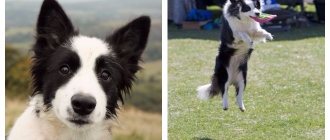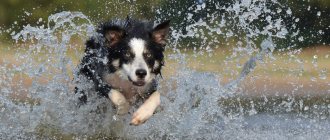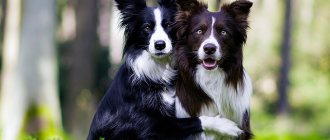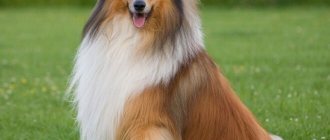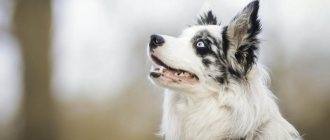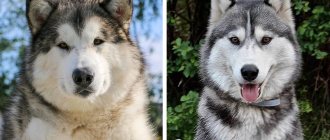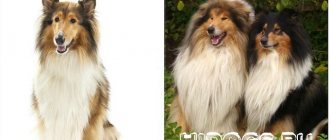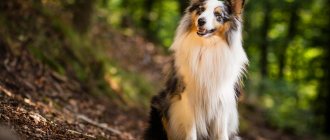Origin story
Scotland is considered the homeland of these dogs, where they quite successfully herded flocks of sheep. Their ancestors were more modest in size and most often had black fur. According to experts, they came to southern England along with nomadic tribes. Subsequently, breeding activities were aimed at further developing their herding abilities. They managed not only sheep, but also goats and pigs.
Collies received their further development thanks to the fact that Queen Victoria turned her attention to the dogs, and she brought several representatives of the breed to England. Here they quickly gained popularity, and many dog breeders became interested in breeding them.
In 1860, this dog was presented at an exhibition as a universal Scottish Sheepdog. In the late 80s, collies came to the United States, and in 1986, the first club for fans of this breed was opened here.
History of breeding the Scottish Sheepdog
Great Britain is the historical homeland of the Scottish Shepherd, as follows from the name of the breed. But why are these dogs called collies? The fact is that in Scotland, where these unsurpassed shepherds come from, a special type of sheep with black faces was common - the locals affectionately called them “collies” (“coll” translates as “coal”). Then this nickname somehow stuck to dogs herding sheep.
Both sheep with black faces and shepherd dogs were called the same in Scotland - collie
Collie-type herding dogs were known in the north of England about a thousand years ago, and by the 15th-16th century they had formed into a breed group, from which various breeds trace their modern history, of which cynologists in many countries are rightfully proud.
Purpose and working specialties
Scottish Shepherds and the varieties of collies derived from them were specifically bred for herding work, in which they still have no equal. But in the modern world, the need for herding dogs has decreased significantly, and collies are increasingly perceived as family dogs.
Collies perform herding work professionally and enthusiastically
Their active and tireless nature does not allow collies to lie idle on a soft sofa - these dogs are not limited to the vague status of companions and master new specialties. They have a lot of talents, enormous potential, flexible nature and excellent learning abilities. Scottish Shepherds make good rescuers and search dogs, they work with great responsibility as guides and canine therapists and, of course, successfully engage in dog sports.
The Scottish Sheepdog is considered one of the best breeds for helping blind people
Popularity in the world
The popularity of collies has always been high, but it reached its peak in the middle of the last century, when the touching series “Lassie” was released on television. Since then, the image of his heroine - a beautiful, devoted and unusually intelligent dog - has been inseparably associated with the Scottish Shepherd breed.
General description of the breed
Each of us learned from our youth that the collie is a dog that you can almost always trust. Her intelligence is enough for five brothers, and her poise and calmness absolutely free her owners from any pitfalls. The Collie is the perfect house dog. This is a surprisingly obedient and affectionate creature, with an embodied predisposition to take care of the younger ones. A sort of wise, older comrade. Also, collies are uniquely peaceful towards other animals.
She will never leave the building, even if it becomes possible for her to do so - because she probably understands that her place is here, close to her family. It is impossible to find a more patient, timid, affectionate and playful friend for your kids than a collie. And, naturally, the sophisticated, aristocratic appearance supports this image of a useful hero. The dogs look simply royal, although they did not immediately become favorites of the highest society.
Initially, the main purpose of this dog (also known as the Scottish Shepherd) was to protect sheep from predators. In this matter, dogs have gained a wonderful reputation, and to this day they can often be seen in the pastures. The name "colley" was borne by a Scottish breed of sheep, which gave its name to the shepherd dogs - colley dog.
The finest hour for the hardworking shepherd came when the British Queen Victoria passed by the pasture during her trip to Scotland. Noticing extraordinary dogs with a gorgeous mane and a long narrow face among the sheep, the queen could not contain her surprise and ecstasy. She immediately expressed her desire to acquire a collie at her own Scottish residence, Balmoral.
Since 1860, these dogs began to appear at exhibitions and gained great fame. This is logical, since in addition to their own decorativeness, they are also extremely gifted. This breed is perfectly trainable, raising it is a pleasure, since diligence and the desire to amuse the owner are inherent in the dog personally by nature.
It is important to realize that collies are active creatures that for centuries have led an extremely active lifestyle, therefore, owners must be prepared for long walks.
Nowadays, in almost all countries, collies are in demand as guard and police dogs. Their intelligence and intelligence, coupled with innate protective instincts, are valued no less than the stranglehold of traditional official breeds. In army times, collies served as messengers, orderlies, and even sappers. Nowadays they are often used as guide dogs - and here they show excellent intelligence and insight.
Border Collie: description
The Border Collie breed is distinguished by its gracefulness, proportional build, and powerful bones. The height of adult individuals, depending on gender, can range from 45 to 55 cm, with a weight from 13 to 23 kg.
This breed's coat can be either long or short. In addition, the dog has a fairly dense and well-developed undercoat. Thanks to this, the dog is perfectly protected from adverse weather conditions. The predominance of white base color is considered a standard indicator.
Border Collie - All about the dog breed | Border collie dog
Breed standards
The Border Collie breed, according to the FCI classification, must meet the following criteria:
- The skull is relatively wide, while the occipital region, although pronounced, is insignificant.
- The length of the skull is comparable to the length of the muzzle, which tapers towards the nose.
- The transition from the forehead to the muzzle is noticeably pronounced.
- The nose is characterized by colors such as black, brown or slate. The nostrils are well defined.
- The eyes are proportional in size, widely set, oval in shape and mostly brown in color.
- The ears are neither small nor large, set wide apart, erect or semi-erect.
- The teeth are quite strong and match the developed powerful jaws, which are characterized by a scissor bite.
- The neck is strong and muscular, slightly arched, widening at the shoulder blades.
- The body is well developed, which is emphasized by fairly springy ribs.
- The chest is somewhat wide and deep.
- The lumbar region is not toned, deep and muscular.
- The back area has a slight slope towards the croup, which is characterized as long and wide.
- The tail area is set low, while the tail is covered with hair and is not thrown over the back.
- The forelimbs are parallel, and they are quite strong.
- The hind legs are gracefully curved at the base of the tail, while they are also strong and muscular.
- The thighs are long and muscular, characterized by proportional curvature at the knees. The hock joints are located low, but it is noticeable that they are quite powerful.
- The paws are oval, armed with short but strong claws, as well as deep pads.
The dog moves freely and softly, raising its paws not too high, which creates the impression of a “sneaking” gait.
The main coat is relatively thick, while the bristles have average stiffness. The undercoat is quite dense and at the same time very soft. The Border Collie dog has a medium-length coat and has a distinctive appearance with a mane, fox tail, and panties.
The breed does not shed as actively. The coat is characterized by the absence of a characteristic odor. Breed standards indicate that the area of the muzzle, ears, parts of the front and hind limbs should have short and smooth hair.
Border Collie Personality
The Border Collie breed is characterized as active and very energetic, so it needs constant physical activity. Considering the fact that this is also a fairly smart dog, it also needs to be stressed mentally. In relation to the owner, as well as to family members, he shows obedience, responsibility and sensitivity, but in relation to strangers he prefers to remain at a distance, without showing unmotivated aggression.
Interesting to know! This fairly intelligent and agile dog is best suited for outdoor games such as agility, as well as freestyle training.
Somewhere around 8 months of age, you should begin the process of training and education. The dog easily learns all basic commands, completely trusting its owner. Among other things, the dog has a unique sense of smell.
How long do border collies live?
A dog of this breed can live for at least 13 years if the pet is provided with the appropriate atmosphere, a balanced diet, and conditions for physical activity from an early age.
BORDER COLLIE. Pros and cons of the breed
Breed standard (appearance)
The dog of this breed is found in two types: short-haired and long-haired. Each has its own exterior features.
- Head. Triangular in shape with an elongated muzzle, the transition from the forehead to the nose is smoothed.
- Eyes. Almond-shaped from light brown to black.
- Ears. High-ranking, regular triangular shape. The tips of the ears should hang forward ⅓. But puppies' ears are delicate, and if you constantly stroke the dog's head, the ears will stand up and it will be difficult to put them in the correct shape.
- Tail. Straight saber-shaped, the tip is raised upward. According to the standard, the tail should not curl into a ring.
- Wool. Dense coat with fluffy and soft undercoat. The long-haired breed has long, soft-to-the-touch fur and a fox-like tail. The paws have a characteristic fringe. The smooth coat has a thick, hard coat and a dense undercoat. The coat fits tightly to the body and reliably protects the dog from humidity, cold wind, and heat.
- Colors. There are three color types of long-haired collies: sable, tri-color and blue merle. Sable color can range from fiery red to light sand. Tricolors have black and red markings on the head and paws, less often on the body. The blue merle or merle color is distinguished by its noble silver color with dark spots, black or gray. According to their exterior, merle dogs should have red spots on their paws and head, but their absence is not considered a deviation from the norm. All three colors of the longhaired breed have a chic white collar, which can be whole or broken in one place, a tassel at the end of the tail and white socks on the paws. On the hind legs only the very tips are colored white, the front legs are highly colored, almost to the elbow.
- Paws. Thin, tall, almost straight. The gait is calm with sweeping movements.
- Back. Straight, no sagging.
- Height at withers. For males from 56 to 61 cm, for females from 51 to 56 cm.
- Weight of an adult dog. From 19 to 34 kg, depending on the gender and appearance of the dog.
- Bite. Standard scissor. But due to the anatomical features of the muzzle, it bites the enemy with its front teeth. This helped the dog pull cattle out of a hole or hole without biting them.
Advantages: balanced, intelligent, calm, friendly towards other animals.
Difficulties: Long walks required.
What is the color and color of collie dogs?
The visible pigment of the outer part of the hair. A significant number of dogs, along with pigmented hair, have white spots or marks in certain areas of the body that are devoid of pigment, i.e. hair lacking pigment. When mixing colors, the color of the dog is determined by the dominant color. A dog has such types of hair as downy, integumentary (smooth), guard hair. The different properties of wool are determined as an adaptation to different climatic conditions and their habitat. Each type of coat and its color requires special care. Breeders have studied how color and patterns are created on the body of an animal. Genes can be responsible for hair structure and color. This is general information that applies to all dog breeds, not collie puppies.
- A. With the help of this locus, a solid color of the pet’s entire body is obtained (monochromatic).
- B. Dyes wool black. Some species have partial of this gene (spotting). Some dog breeds necessarily have this gene!
- C. This is the key component! With its help, the body produces color throughout the body. If this component is missing, the dog may be born without color (albino). The color of the nose and iris does not depend on this component.
- D. If there is little gene in the pet’s body, then the coat will be lighter. If there is a lot of gene in the body, then the dog will have a rich black color. The gene affects the viability of the dog; if a pet is born with a lack of the gene and a blue color, then he may most likely not live to see his senior years. When the gene is dominant, the color of the pet turns out to be black.
- G. With old age, this component is activated and gray hair appears. They call him gray-haired. When the color turns gray.
- E. With its help, in most cases, three-color colors are obtained, containing pigment of black, brown and yellow.
- M. The gene leads to anomalies for the pet and gives a harlequin pattern. Has a marble color. With old age, the gene can lead to lightening of color.
- S. This gene causes partial body pigmentation in dogs. (white spotting).
- T. The gene is characterized by mottling. It is opposite to the S gene and forms dark spots on white areas.
- R. Chastity - alternation of hair that is colored and not.
Varieties
There are two types of breed - long-haired and short-haired collies. Both varieties have some differences in appearance and character.
- Long-haired look. A model of aristocracy and obedience. The variety is more massive, males weigh 26-34 kg, females - 19-26 kg. The main distinguishing feature of the exterior is a thick, soft, warm undercoat and long guard. Thanks to his calm, friendly, patient disposition, he is suitable for the role of a companion and nanny.
- Smooth-haired appearance. An elegant and “light” dog. Males weigh 20-29 kg, females - 18-25 kg. The exterior is distinguished by a thick undercoat and short, stiff hair. Compared to their “furry” relatives, they show more activity, curiosity, and sociability. Some representatives of the breed may express distrust of strangers, but they rarely show aggression. Shows good guard and hunting instincts.
Despite the similarity in origin and appearance of the collie and the Sheltie dog, these are two separate breeds. The ancestor of the second is the Border Collie, not the Scottish Sheepdog. Therefore, the Sheltie cannot be considered a miniature collie.
Origin of the breed
To be precise, collies are not a separate breed, but a group of herding dogs whose homeland was the highlands of Northern England and Scotland. This group includes many varieties, both recognized by cynological organizations and small local breeds.
There are several versions explaining the name. According to one of them, collies got it from the Anglo-Saxon word for “black”, according to another, from Scottish black-headed sheep and livestock guarding dogs.
There are many hypotheses about the origin. Some scientists claim that they were brought to Iceland by the Vikings, while others are inclined to believe that they migrated to Britain thanks to Roman nomads about two thousand years ago. Be that as it may, we can safely say that collies are one of the oldest breeds.
They owe their popularity to Queen Victoria, who, when visiting a castle in Scotland in 1960, was fascinated by the beauty and grace of long-haired dogs. It was thanks to the queen that collies came to England, where they immediately found admirers for their temperament and unusual exterior. In the same year, collies were exhibited for the first time in Birmingham in the universal “Scottish Sheepdog” category.
Modern representatives of the breed are somewhat different from their ancestors. Initially, shepherd dogs were predominantly black in color, with a powerful and squat body. However, matings between long-haired and short-haired individuals, which were allowed in the 1970s, led to the collie's body becoming elongated and not so wide.
Care
While short-haired dogs usually do not require much attention (except for occasional brushing), caring for long-haired collies is a hassle. You need to have not only different types of brushes and combs, but also a spray bottle of water, which is necessary so that the collie’s fur is not subject to electrification. You need to comb your dog according to hair growth: start from the neck and gradually move to the body.
Experts advise washing your collie as little as possible. This is really a necessary procedure only after estrus, molting and childbirth. Dogs participating in competitions are washed before exhibitions. However, it is worth remembering that when washing, a special layer of skin is erased, and therefore the dog becomes susceptible to various diseases, especially the Belgian Mastiff. You should carefully clean your collie's ears and also wipe off discharge from the eyes with a cotton swab. Remember, however, that a lot of mucus indicates problems that only a veterinarian can solve!
Standard
At exhibitions, a dog is evaluated through a certain breed standard, when external indicators and character traits are described.
To realize its natural inclinations for shepherding work, the animal must be physically strong and have harmonious external characteristics.
Collies have gained popularity, among other things, due to their beauty, so to meet the standard, they should not have disproportionate body parts.
The size of the head must have certain proportions in relation to the rest of the body.
Eyes are one of the most important characteristics of the breed and are designed to complement the pleasant impression of appearance.
The breed standard requires collie ears to be well set at a show, which can tell a lot about the character of the dog. You can't force a cowardly animal to raise its ears.
The body, neck and limbs of the dog must be assessed as a whole.
The dog's movements are one of the most important characteristics and should be smooth and graceful.
The established standard does not allow elbows to be turned out and paws to be braided. The correctness of movements says a lot about the physical fitness of the animal.
The dog's coat should not be too overgrown, as this will lose its elegance and make the collie look like a ball of fur.
The standard specifies three main colors:
- sable;
- marble blue;
- three-color.
All three colors can be diluted with white markings of one size or another.
A white chest and a white tip of the tail are especially preferred, but the standard does not provide for special requirements in this case.
Feeding
It is important that any dog receives all the necessary microelements and vitamins. All useful substances are contained in dry food, but feeding should not be limited only to them. Your pet needs to eat meat at least a few times a week, which is known to be rich in proteins. It is also useful to give different vegetables (tomatoes, carrots, cabbage), herbs and cereals.
Adult Scottish Shepherds need to be fed twice a day. At the same time, food should not be left in the bowl, but water must be available to the dog at any time of the day.
Diet
You should carefully choose what to feed your Scottish Shepherd, as the breed is prone to allergies and food poisoning. You need to make a choice between dry and wet food. The first includes dry granules, the second includes canned meat for dogs and natural products (meat, vegetables, fruits, milk). Mixing food types is not recommended.
“Drying” should be purchased only of the highest class, containing all the necessary substances. This type of feeding is more economical and convenient, as it does not take time to prepare. Owners will have to create an individual menu themselves, based on the experience of dog breeders and the advice of veterinarians. The table shows foods that should be included in your pet's diet and which should be avoided.
Table - Permitted and prohibited food products
| What is possible | What not to do |
| - Boiled beef; - liver; - eggs; - sea fish fillet; - cottage cheese; - cheese; - porridge; - fresh vegetables; - seaweed; - medicinal herbs in the form of supplements | - River fish; - bones; - peas; - pork; - salo; - pearl barley; - potato; - sweets; - flour products |
The dog must be fed strictly at the same time. Puppies from two to eight months are fed four to five times a day in small portions. By the age of one and a half years, food intake is reduced to three times. An adult dog is fed twice a day.
Features of feeding and diet
You need to choose what to feed your dog - dry food or natural food. “Drying” is more convenient to use. There is no need to fuss with pots or waste time preparing food. You need to choose high-quality dry food.
You should not feed your pet more than normal, even if the portion seems small to you. This is especially true for high-protein feeds.
Dogs love natural food more and eat it more willingly, but then you need to carefully plan the diet so that there is enough protein, fat, carbohydrates, vitamins and minerals. Foods that should not be given to Scots:
- tubular bones;
- sweets and flour;
- river fish;
- legumes, potatoes;
- fatty meat, lard.
It is not recommended to mix both types of nutrition.
Puppies begin to be fed at 2-3 weeks, they receive six meals a day plus breast milk. Month-old babies should confidently eat from a saucer. Up to seven months, puppies are fed 4-5 times a day, from seven months to 15-18 - three times. An adult needs two meals a day.
Breeding
Due to the fact that this breed is recognized as one of the most popular, many are actively involved in collie breeding.
Their pregnancy lasts 56-68 days, it can be determined at 4-5 weeks. During the period of bearing collie cubs, you should walk at least twice a day for 1.5-2 hours, but training should either be stopped or minimized.
Buy a Border Collie: Tips and Tricks
The Border Collie breed was bred specifically to serve as a herder or as a helper for a human shepherd. In this regard, it should be noted that the dog is practically devoid of aggressiveness. Animals that are not intelligent and quick-witted are rejected.
Various tournaments, both world and domestic, make it possible to identify animals that are subsequently used in breeding work. All responsible breeders have an interest in their animals taking part in such events.
Where to buy and what to look for
It is advisable to buy Border Collie puppies from specialized nurseries that practice breeding dogs of this breed. In domestic nurseries you can buy a puppy that is in no way inferior to foreign puppies by breed standards.
Recently, it has been generally accepted that this breed is universal, so before buying a puppy you should decide on its further purpose. Some puppies that are not high-end puppies will make excellent companion dogs and family friends.
Important point! If you plan to use the dog in the future to participate in exhibition shows, then it is better to choose an animal of a higher class, but such puppies are more expensive.
Border Collie price
The cost of puppies, regardless of breed, is one way or another influenced by factors such as the achievements of their parents, the class of the puppies themselves, the status of the nursery and some other, less important ones.
Puppies of the lowest “pet class” are not intended for participation in exhibitions or breeding work. Despite the presence of some defects, they do not affect the health of the animal as a whole.
Such a puppy, which will simply become the favorite of the whole family, can be purchased for 15 thousand rubles. Puppies of a higher “breeding class” are more expensive and can be purchased for at least 20 thousand rubles. But such puppies can be used in the breeding process in the future.
The most expensive ones are “show class” puppies and you will have to pay at least 30 thousand rubles for them. Such animals participate in various exhibitions and represent the category of standard representatives of this breed.
Collie character
The breed includes several varieties of dogs that share common characteristics:
- the shepherd is attached to its owner, but the cables try to dominate closer to one and a half years, so toughness of character is required in education;
- The shepherd instinct is in the animal’s blood, so the dog does not tolerate it when its family disperses in different directions. He will run vigorously and gather the whole family while picking mushrooms, walking in the forest or park;
- treat other animals in the house well. He will not chase strange cats on the street, only in the most extreme cases, when he gets bored;
- long-haired dogs are less active and do not like long games; short-haired dogs, on the contrary, prefer to run and jump endlessly;
- the breed is not suitable for keeping on a chain, since the breed needs to run at least 3 km per day;
- loves water and has a desire to swim in open waters in summer;
- the dog accepts children well and will play various games with them, steadfastly endures being grabbed by its fluffy tail or hugging its long muzzle;
- The dog is smart and remembers commands well; the breed often takes part in circus performances and is suitable as a guide dog. A good choice for beginner hobbyists;
- have a keen sense of smell and are used to find people under rubble;
- the dog has good endurance and is suitable as a companion for older people;
- Be wary of strangers and will monitor the owner’s attitude towards another person. If the owner shows complacency, the dog calms down and even allows himself to be petted;
- A vindictive breed, it remembers its offenders and can bite on the sly after some time.
A collie will be a great friend for your child and will brighten up the days of an elderly person, but the dog needs a daily walk without a leash. The medium size and light shape allow you to keep the dog in small apartments, but before buying a puppy you should take into account the animal’s thick undercoat. During shedding, dog hair will be everywhere, including the bed. Therefore, the breed is not suitable for lovers of ideal cleanliness in the house and people with a tendency to allergies.
Hygiene
How to Groom a Collie Dog
Neither the long-haired nor the short-haired varieties are trimmed or trimmed. The exception is the bearded representative, whose bangs cover his eyes. As contamination occurs, water procedures are carried out every 2-3 weeks. For bathing, a softening shampoo is recommended, which is purchased at veterinary pharmacies and specialized stores. A dog's coat may become dull due to the dry air in the apartment during the winter.
Important! If a collie has been bitten by a tick, it is difficult to find it due to its dense coat. Therefore, in the warm season, the undercoat is checked for the presence of ticks and other parasites.
It is recommended that your pet have its nails trimmed once a month, its eyes treated with a special solution once a week, and its ears cleaned with a cotton swab.
Health
Films about Lassie, an incredibly smart and brave dog, once made the dog breed one of the most fashionable breeds; unfortunately, such popularity negatively affected not only the appearance, but also the health of dogs of this breed. Indiscriminate breeding has perpetuated negative gene mutations, as a result of which today's collies are predisposed to a number of diseases. The so-called “collie eye syndrome” is characterized by retinal atrophy and detachment, as well as cataracts. However, vision is not the main sense for dogs, and even a visually impaired collie is able to lead a relatively normal life. Hereditary diseases characteristic of these breeds include congenital deafness, which often affects dogs with merle coloring and blue eyes, ectopia of the ureters, distichiasis, entropion (entropion), and degenerative myelopathy. Collies can also suffer from epilepsy, vitiligo, and yeast dermatitis.
Every owner should remember that there are a number of medications that are contraindicated for their pets. The greatest dangers for collies are ivermectin and loperamide; these drugs cause severe depression of the central nervous system and can be fatal. Antibiotics, antitumor drugs and cardiac glycosides should be used with caution. Even if the dog’s illness does not seem serious to the owner, self-medication should still not be done. You should only trust your dog’s health to veterinarians who are not only familiar with the characteristics of the breed, but also know the composition of medications.
Training
Distinguished by its high intelligence, the Scottish Shepherd is easy to train and always willingly follows the commands of its owner. The dog needs gentle handling, otherwise the dog will become overly modest or stubborn. Even a novice dog breeder can easily handle dogs of this breed. Collies are not only excellent shepherds, these dogs are used as guide dogs and rescue dogs.
Collie dogs are excellent for both apartment living and country house keeping. A dog kept in an urban environment requires regular exercise and long walks. If the dog lives in a rural area, then you need to take care of a shady place in the yard, as the dog may overheat. The dog should also always have access to fresh drinking water. The Collie does not need a large territory; a medium-sized yard is enough for the dog.
Training and education
Collies are smart, so training them is not at all difficult. Sometimes, having noticed a weakness in the owner, the pet can be stubborn, cheat and pretend that he does not understand the trainer’s requirements. Such tricks need to be stopped, but not with rudeness and physical punishment, but with calm persistence, consistency and rewards for excellent academic results.
From the age of two months we begin to teach the puppy the simplest commands. Having mastered the basic, basic requirements, the dog is ready for a more complex training course. Including agility. Dog handlers recommend spending one week studying one command. Of course, each dog is individual; when choosing a sequence, you must be guided by the abilities of your pet.
Interesting Facts
- The first mention of collies dates back to the fourteenth century and belongs to the poet Chaucer.
- A collie named Dick earned military glory by detecting 12,000 mines during his service. Including a huge land mine under the Pavlovsk Palace in Leningrad. Despite three wounds, the dog lived to a ripe old age and was buried with full honors.
- The lack of aggression in Scottish Sheepdogs is explained by the fact that wolves were exterminated in the British Isles. Therefore, unlike other herding dogs, the duties of the collie did not include fighting predators; the dogs only herded livestock.
- Collie wool is medicinal; products made from Scottish Shepherd wool (socks, belts...) not only save you from the cold, but also relieve pain and heal from illnesses.
- During the Russo-Japanese War, collies were used as orderlies, and during the Great Patriotic War they delivered secret documents.
- The female role of Lassie in the famous series about a collie dog named Lassie was always played by collie boys.
Diseases and treatment
Despite its energy and cheerfulness, the collie dog breed acquired several genetic diseases during the selection process. It is not necessary that your pet will develop possible diseases during its life. However, you need to be prepared for health deterioration due to reasons beyond the dog owner’s control. The breed is predisposed to the following diseases:
- anomaly of eye development - can lead to blindness; to identify it, you need to undergo special tests;
- inversion or inversion of the eyelid - corrected surgically;
- congenital deafness - more common in blue merle collies with light eyes;
- degenerative myelopathy - leads to paralysis, diagnosed by specialists;
- skin lesions - dermatitis, pemphigus, treated with medication;
- epilepsy - detected by ultrasound of the brain, incurable;
- ectopia of the ureter - creates a risk of infection of the genitourinary system.
Many representatives of the breed are sensitive to medications, including anti-worm medications. Before purchasing medication, get your dog medically examined and consult a professional veterinarian.
Puppies
Despite the onset of the first heat in a six-month-old bitch, she will only be able to become a mother at the age of 18-24 months. Males are ready to untie by the age of two years. Mating is carried out on days 9-14 of the cycle, when ovulation occurs, and is repeated after one or two days. It is easy to find out about the readiness of mating by the playful behavior of the bitch towards the opposite sex.
If pregnancy occurs, the calcium content in the diet should be increased until the end of the puppies' feeding period. Pregnancy lasts 56-66 days. Starting from day 30, it is necessary to reduce physical activity and increase the amount of vitamins and minerals in daily nutrition. Collies do not have problems with childbirth; the bitch is able to give birth on her own without human help. However, it is better to be monitored by a veterinarian throughout the pregnancy.
Prospective parents must have pedigree and titles to prove they meet the standards. It is not advisable to breed dogs “without clan, without tribe”. It is not necessary for a bitch to have puppies; this does not affect her health in any way.
TOP nicknames
Collie combines aristocracy with rural good nature. Therefore, ringing but noble nicknames are suitable for representatives of the breed. It is recommended to choose English names. Examples of nicknames are given in the table.
Table - Options for names for dogs
| How to name a collie “boy” | How to name a collie “girl” |
| — Alan; - Frankie — Oscar; — Starkey; — Woody; — Gary; — Jazz; — Mike; — Ford; — Macbeth | — Leia; — Polly; — Gerda; — Cleo; - Mira; — Clara; — Utah; — Sarah; — Laura; — Kiki |
Try to choose nicknames that are not similar to the sounds of the commands. Otherwise, the pet may get confused and not understand what is required of him. Say the name softly, clearly and loudly. Use your pet's name during praise, play, and on walks so that the dog has a positive association with the name.
Cost and where to buy
How much a collie puppy costs will depend on what the dog is taken for. Hand-picked puppies without a pedigree are sold at prices starting from 6 thousand rubles. Participation of such dogs in exhibitions and breeding is impossible. The price of a collie with all documents is 15-35 thousand rubles. Future show-class champions can cost 80-120 thousand rubles. (Cost data is as of February 2018).
Nurseries
Choose only proven collie kennels with a good reputation. Before purchasing, ask the breeder for a puppy vaccination card and pedigree, and inspect the puppy for marks. Conscientious breeders love their pets, keep them well, and protect them. A good nursery means help and support in the future. Any issue can be resolved by consulting with the breeder.
There are a number of Scottish Shepherd kennels in Russia and the CIS:
- Big Hope in Moscow - https://freya93.wixsite.com/collie;
- "Niksend" in the Moscow region - https://www.niksend.com/;
- Lunar Lakes in St. Petersburg - https://lunarlakes.narod.ru/index.htm;
- "Eldvidzh" in Pskov - https://eldvidzh.ru/;
- “Collie-Berezniki” in the Perm region - https://collie-berezniki.jimdo.com;
- "Silvent Line" in Tambov - https://silvent-line.jimdo.com/;
- Lavita in Novosibirsk - https://www.kennellavita.com/;
- "Daenerys" in Anapa - https://deineris.jimdo.com/;
- Prokseny in Minsk - https://prokseny.16mb.com/.
Collie (Scottish Shepherd) - will become a member of the family. You won't be bored with your pet. You can keep a dog both in an apartment and in a private house. Problems with fur will not arise if you comb your pet on time. The breed is not suitable only for very busy people who rarely appear at home.
LAIKA: HISTORY OF THE DOG AND CHARACTER
PUG: HISTORY OF THE BREED AND CHARACTER OF THE DOG
GERMAN SHEPHERD - HISTORY OF THE BREED AND CHARACTER
TIBETAN MASTIFF - HISTORY OF THE ORIGIN OF THE BREED
Character and intelligence of the mini collie breed
Among breeders, Sheltie dogs are considered family-friendly, loyal, active animals. We will consider the main manifestations of character below.
Attitude towards children and others
1. Attitude towards children. The dwarf collie is an excellent four-legged friend for families with small children. They are not aggressive, calm, and not vindictive. Children are seen as friends, playmates. They become attached to the babies and sometimes stay overnight next to them as a fur pillow. Dogs calmly react to sudden movements of the baby, pestering, tugging on the ears or tail.
2. Attitude towards the owner. One of the few breeds that chooses one person as its owner. It becomes a father, mother or child. The object of their adoration and respect, they will obey unquestioningly, carry out any commands, and are easy to train.
3. Attitude towards a stranger. In this regard, Shelties are rather reserved animals. If the owner communicates with the stranger in a friendly manner, the dog will calmly sit next to him and wait for the conversation to end. If a medium-sized collie senses danger posed by a strange guest, then growls and even teeth are used. An interesting fact is that the dog will perceive the approach of a stranger during sleep as an immediate threat and will become nervous.
Training
Thanks to their high intelligence, dogs are amazingly easy and willing to train. The training is successful for both the owner and the pet. Fluffies enjoy following commands, and they do it clearly, coordinated, literally “grabbing everything on the fly.” Don't forget to thank your little family member for his obedience with kind words or a tasty morsel. This will speed up the process of remembering requests and increase your pet’s desire to learn something new.
